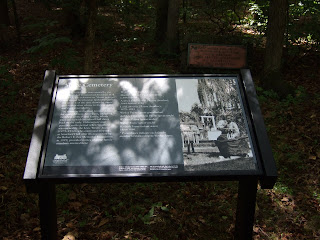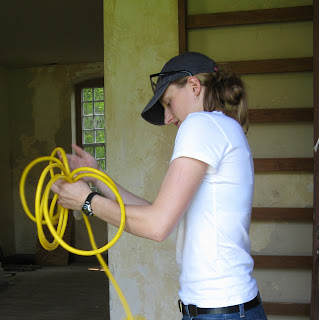
All of the signs funded with the help of the Chesapeake Bay Gateways Network focus on the 17th-century, before the Lee family lived at Stratford. Two new waysides are located at the Clifts Plantation site, where the Pope family lived when they owned this property in the 1600s. Another one of the signs is on the northeast side of the house, near the Octagon building, and it interprets American Indians who would have lived on these lands. The rest of the signs are located on various hiking trails: Early forests are discussed in the sign on the Little Meadow Trail; the differences between the Chesapeake Bay then and now are interpreted on the Mill Overlook Trail; Stratford's Miocene-era cliffs are featured on the Silver Beech trail; and the history of the Mill Pond area is interpreted on the sign placed near the Mill Pond trail.
In addition to these seven signs, we also placed one that was not part of the grant. This one focuses on the slave cemetery located next to the Council House. There is a small marker in the cemetery from the 1950s, and this new sign explains the meaning behind that marker. In the slave cemetery, we chose to explain the 1950s marker and name some of the slaves who we know are buried in that area.
.jpg)
I hope that the next time you come to Stratford Hall, you look for and read these new waysides. If you have additional questions or comments about them, please let us know!


 quarters located southeast of the Stratford Great House. Our curatorial department is currently developing a new furnishing and signage plan for one of these. Aided by 18th-century documentation, this will offer a much-enhanced understanding of the daily lives of four identified members of the Lee slave community. Not only will these improvements enlighten day-to-day visitors, but they will also be valuable assets to our interpretive staff who lead students through the “Slavery” unit of our Educational Adventure field trip program.
quarters located southeast of the Stratford Great House. Our curatorial department is currently developing a new furnishing and signage plan for one of these. Aided by 18th-century documentation, this will offer a much-enhanced understanding of the daily lives of four identified members of the Lee slave community. Not only will these improvements enlighten day-to-day visitors, but they will also be valuable assets to our interpretive staff who lead students through the “Slavery” unit of our Educational Adventure field trip program.







